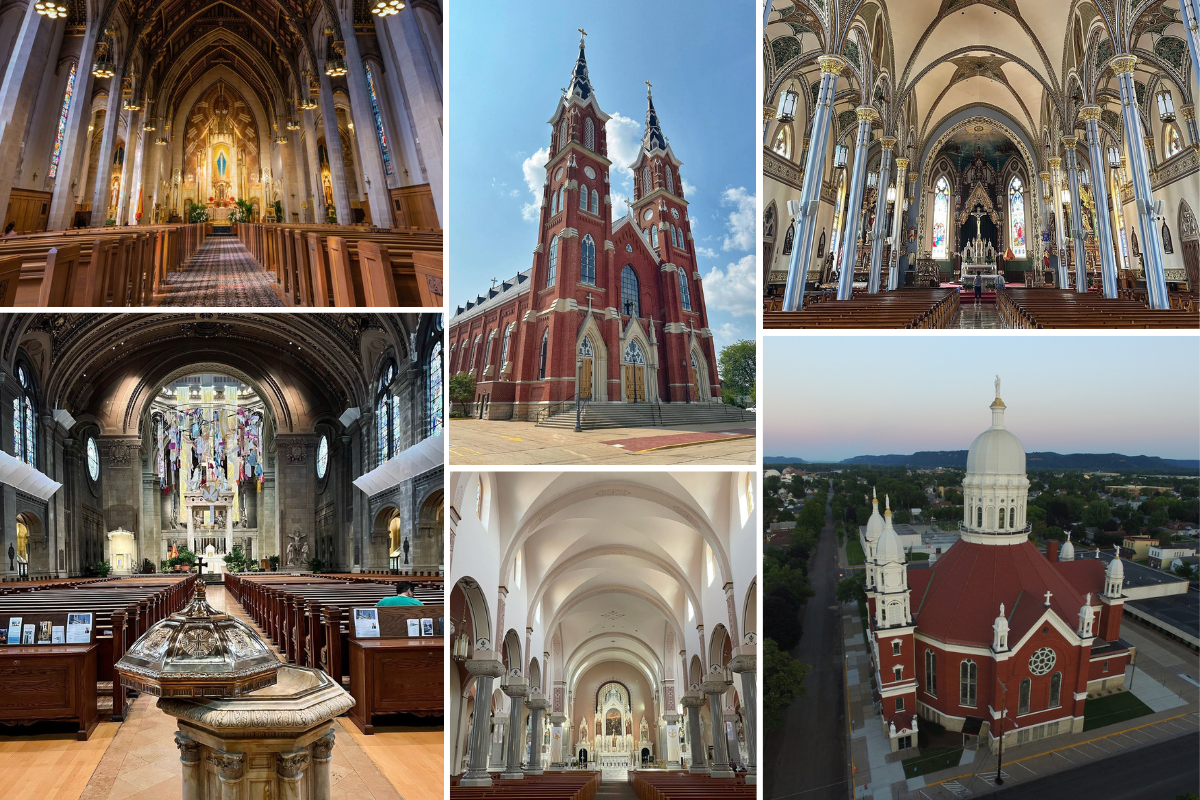See the Beautiful Confluence of Religion and Architecture at These 25 Midwest Basilicas
From the grandeur of the Basilica of the Sacred Heart in Indiana to the historic significance of the Basilica of St. Josaphat in Wisconsin, Midwest basilicas are sacred spaces with deep religious and cultural significance. They’re also marvels of architecture, whose careful craftsmanship has stood the test of time and draws visitors from around the nation and the world.
A basilica is a designation given to certain churches by the Pope, which grants them special privileges. All US basilicas are minor basilicas and are usually bestowed this honor due to historical significance, architectural beauty, or liturgurical renown.
Whether you are a history buff, an architecture enthusiast, or simply interested in religious landmarks, Midwest basilicas offer a unique and enriching experience for all who visit.
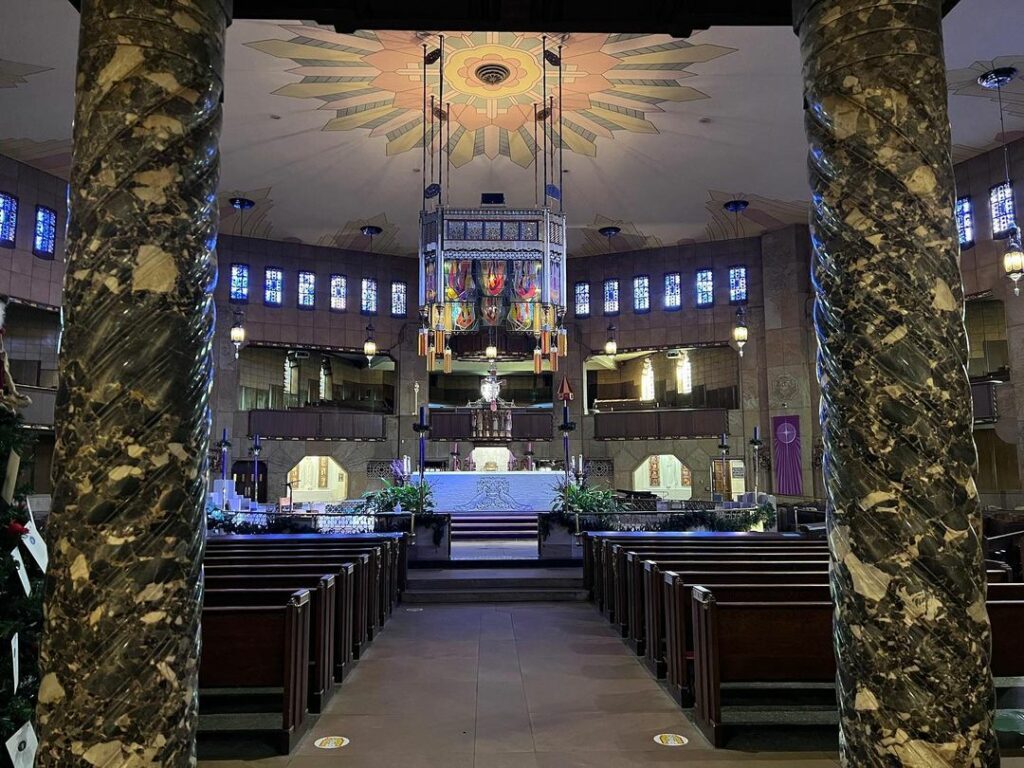
National Shrine of the Little Flower
2100 12 Mile Rd, Royal Oak, Michigan
Completed in two stages between 1929 and 1936, this Catholic Church in Metro Detroit is well-known for its zig-zag Art Deco style. It’s named in honor of Saint Therese of Lisieux (known as the “Little Flower”).
The basilica’s central tower — known as the Charity Crucifixion Tower — features a 28-foot-high figure of Jesus Christ that faces Woodward Avenue.
Elsewhere inside the church, visitors can see the Four Evangelists in the tower’s upper corners, the Last Seven Words From the Cross carved below the Christ figure, and other religious depictions.
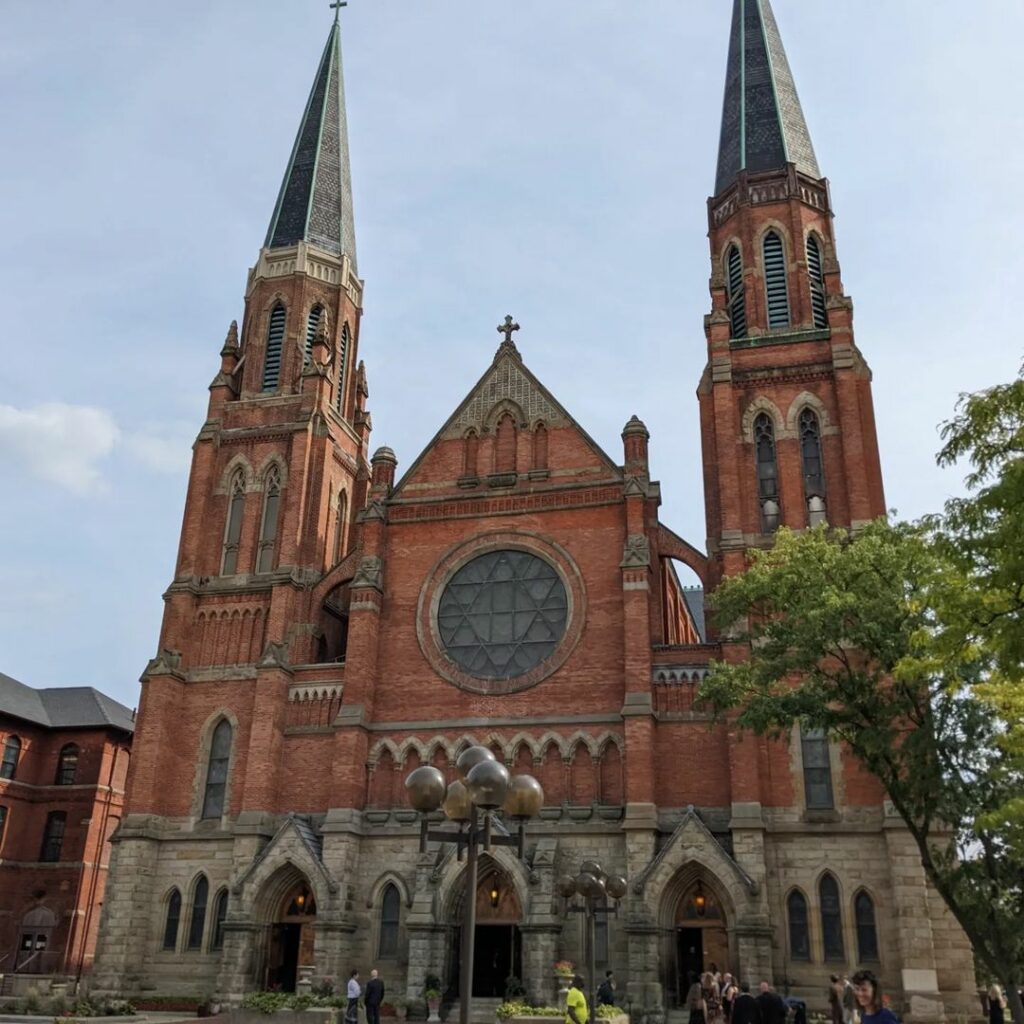
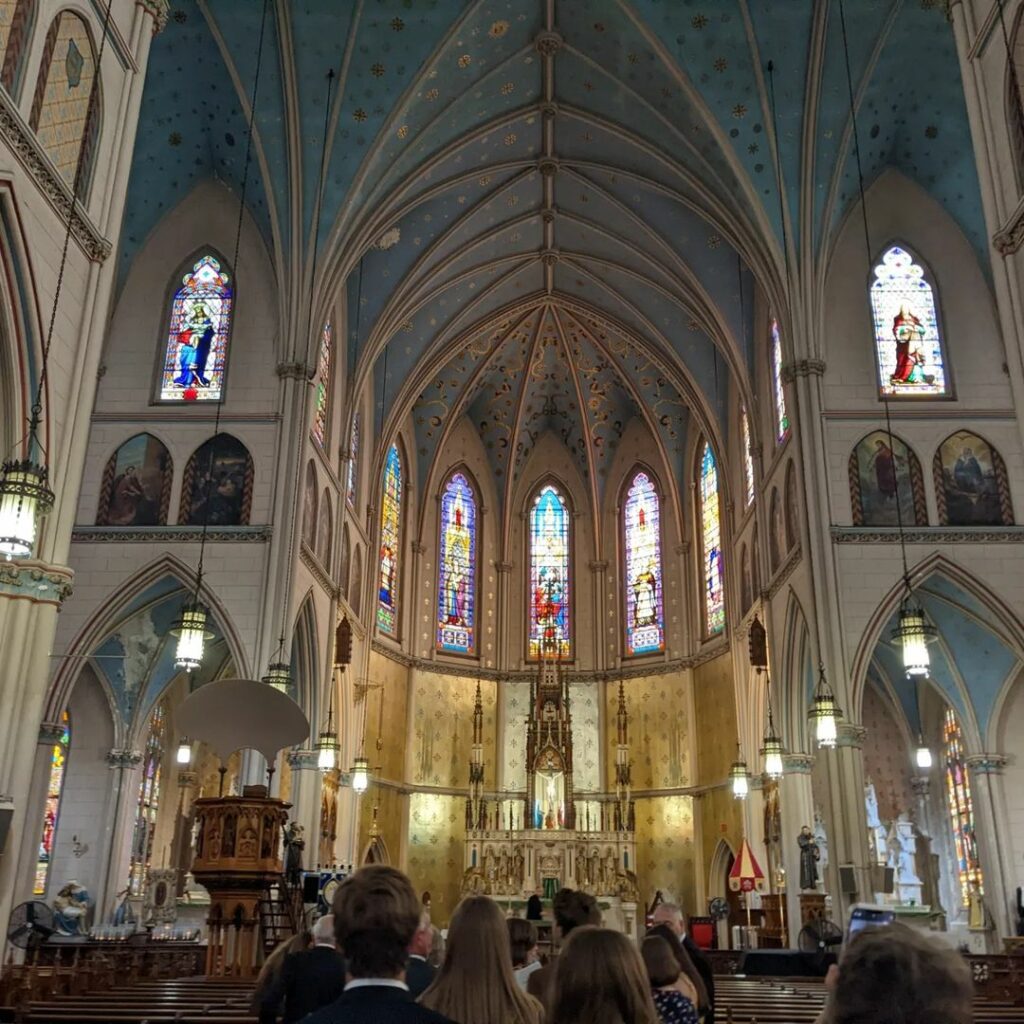
Basilica of Sainte Anne de Detroit
1000 St Anne St, Detroit, Michigan
Founded in 1701, the Basilica of Sainte Anne is the nation’s second-oldest continuously operating Catholic parish. The current church was built in 1886 in a Gothic Revival style. The cathedral’s flying buttresses pay homage to the city’s French history and the building also features four gargoyles at its main entrance as well as the oldest stained glass in the city.
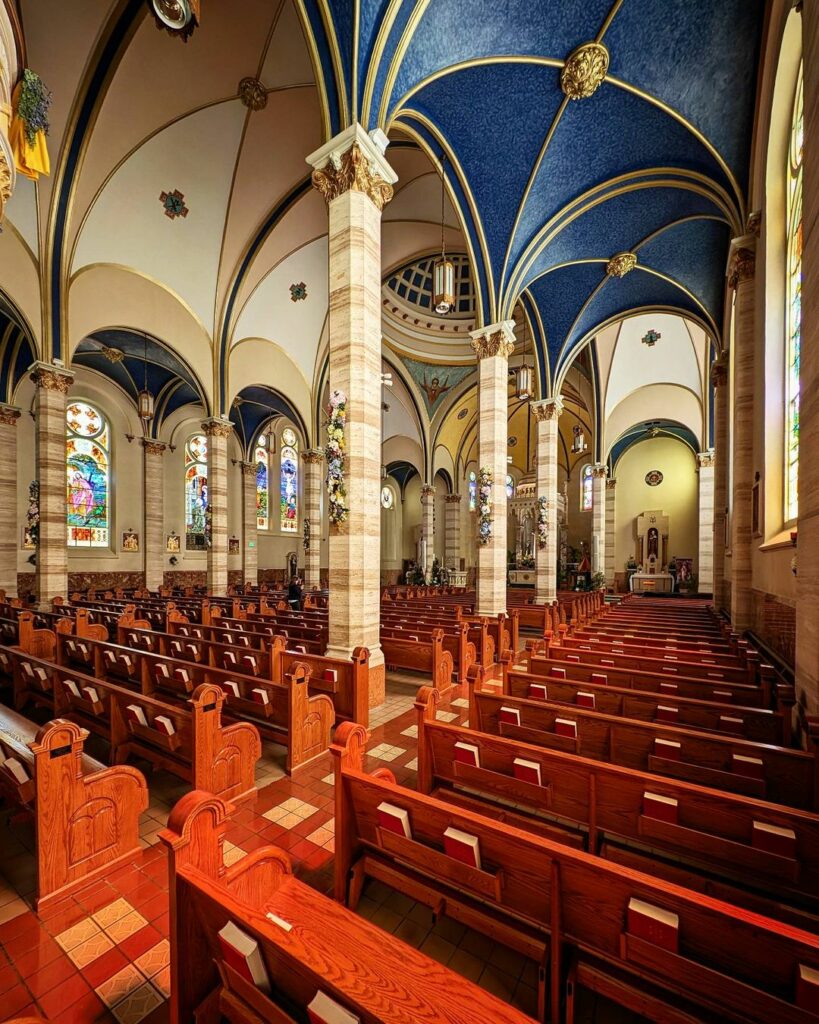
Basilica of St. Adalbert
654 Davis Ave NW, Grand Rapids, Michigan
Dating back to 1881, the basilica is named for St. Adalbert of Prague, the Patron of Poland, where most of the church’s first parishioners came from. It started as a small wooden church in the late 1880s and was originally known as Assumption of the Blessed Virgin Mary Church.
The basilica’s exterior is covered in limestone and two towers that flank the facade rise 134 feet. A large central dome, which retains both Gothic and Byzantine influences, rises 134 feet as well.
The cathedral also has stained glass windows created by German craftsmen and the pews were designed locally — a nod to the city’s history as a furniture industry powerhouse.
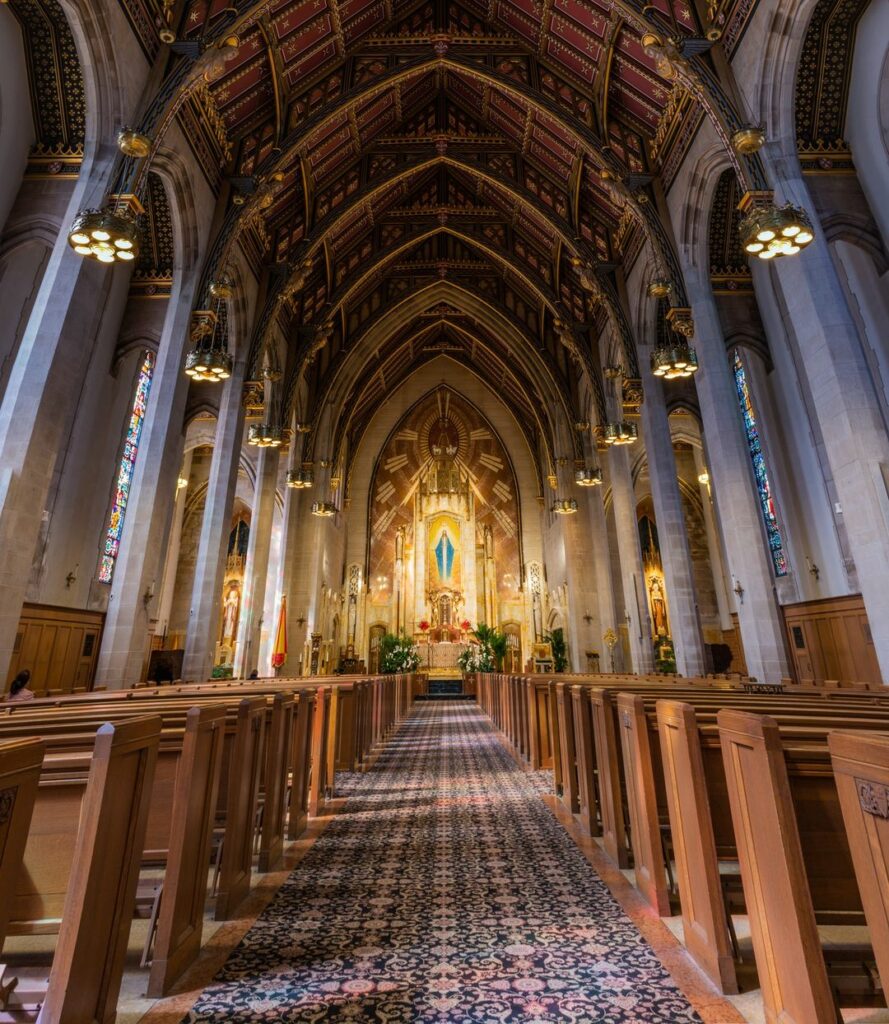
Queen of All Saints Basilica
6280 N Sauganash Ave, Chicago, Illinois
Founded in 1929 as a portable wood-frame church, the current church, designed in a Neo-Gothic style, was completed in 1960. Its features include eight different shrines of the Virgin Mary in a large window over the choir loft — designed to allude to the theme of universality in the Catholic Church.
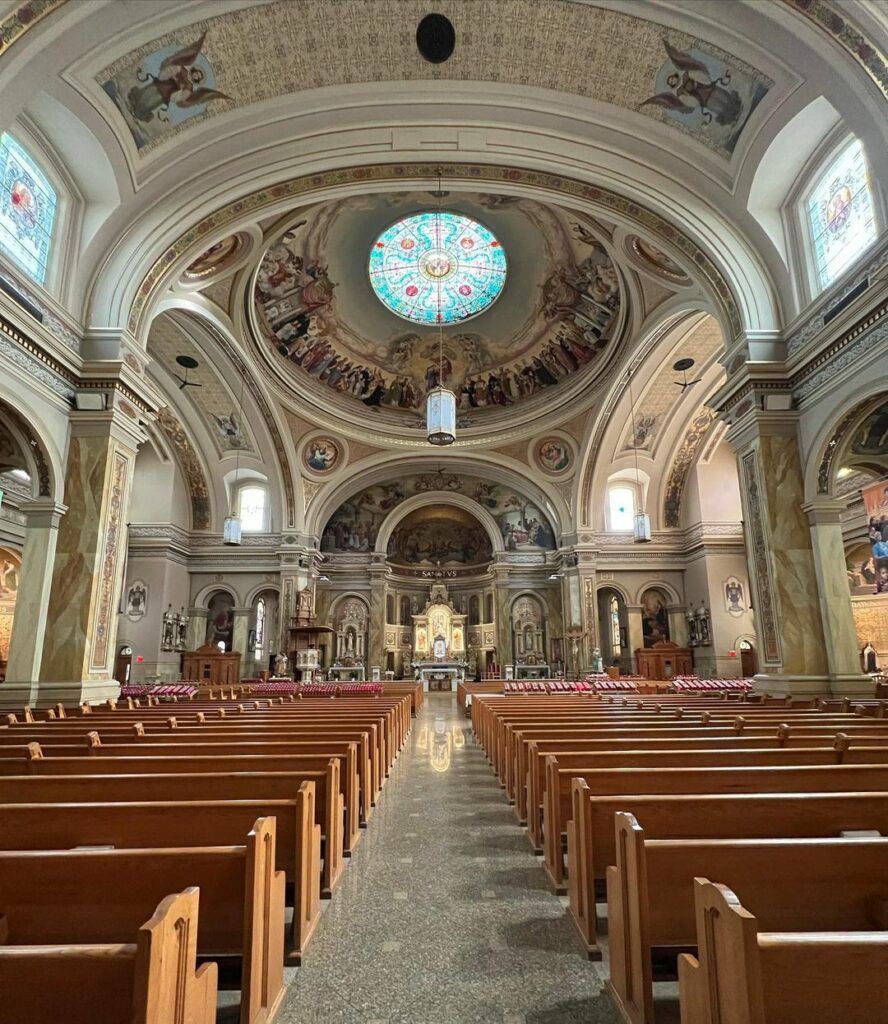
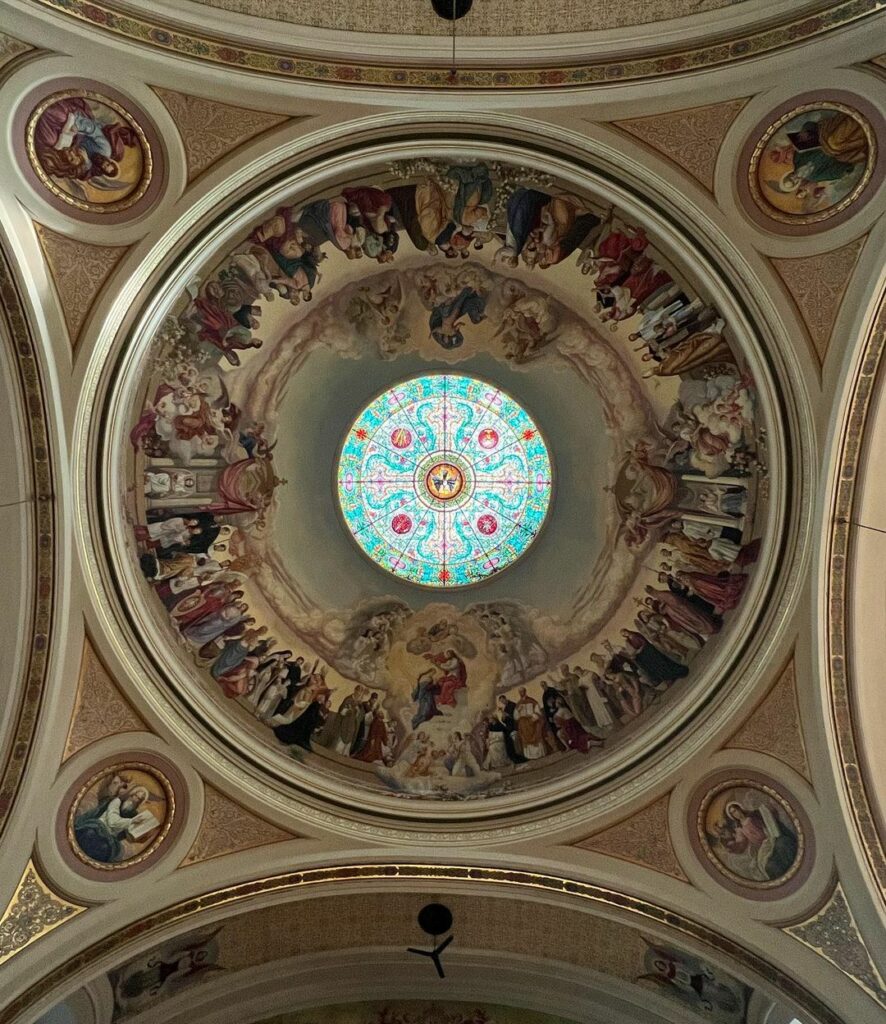
Basilica of Saint Hyacinth
3636 W Wolfram St, Chicago, Illinois
Founded in 1894, Saint Hyacinth is a shining example of the Polish Cathedral style of churches. It’s well-known for its three-towered facade, a rarety in American churches, and also home to masterworks of several renowned painters.
Inside the church, a number of statues can be found, including St. Joseph and St. Ann. A huge saucer dome hangs over the church crossing and features a giant mural depicting more than 150 figures.
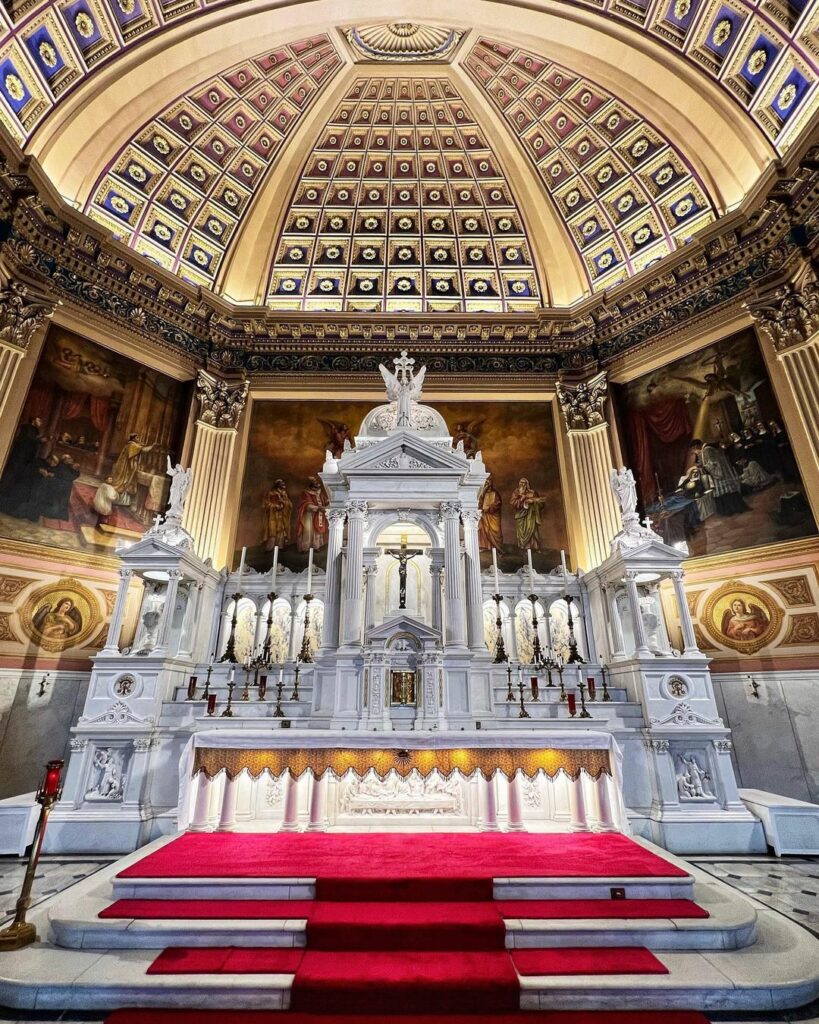
Our Lady of Sorrows Basilica
3121 W Jackson Blvd, Chicago, Illinois
Founded in 1874, the parish has had a diverse congregation over time and is known as one of the nation’s few Black basilicas. The church, dedicated in 1902, was designed in an Italian Renaissance Revival architectural style and features a barrel-vaulted ceiling and a high altar made of Carrara marble.
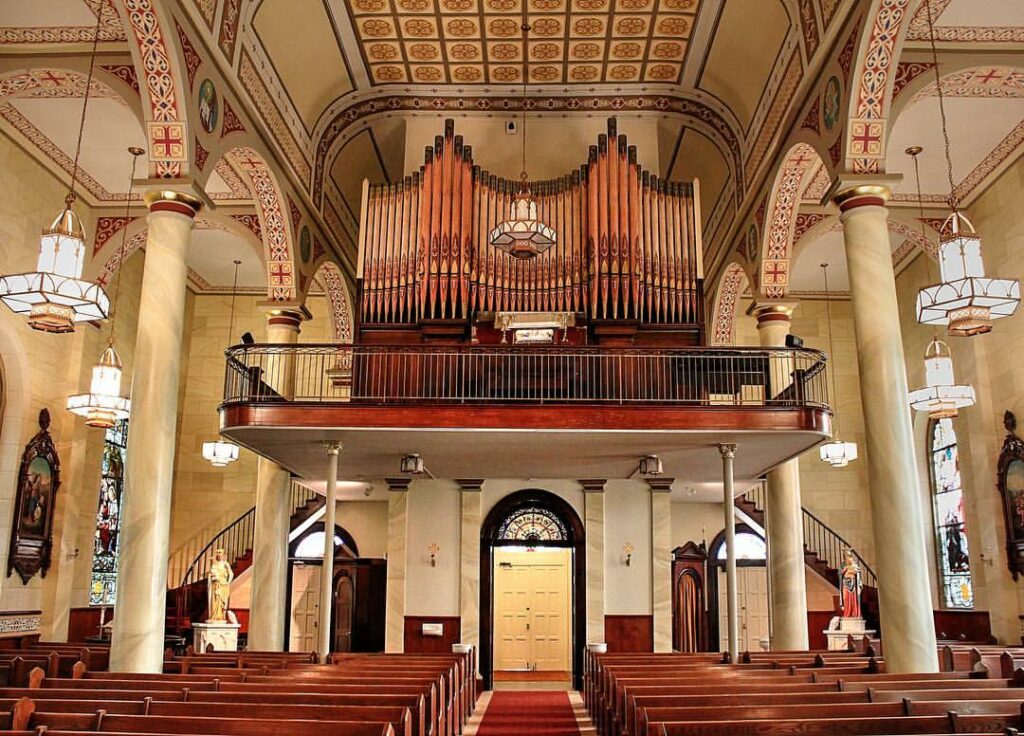
St. Francis Xavier Cathedral and Library
205 Church St, Vincennes, Indiana
Known simply as “The Old Cathedral,” St. Francis was established around 1734 and is the oldest Catholic parish in Indiana. The current church dates from 1826 and was built in a Greek Revival style.
The small brick building that houses the library was built in 1840 and features Bishop Simon Brute de Remur’s personal collection of 5,000 books and documents, and now includes more than 11,000 items, including a document from Pope John XXII from 1319.
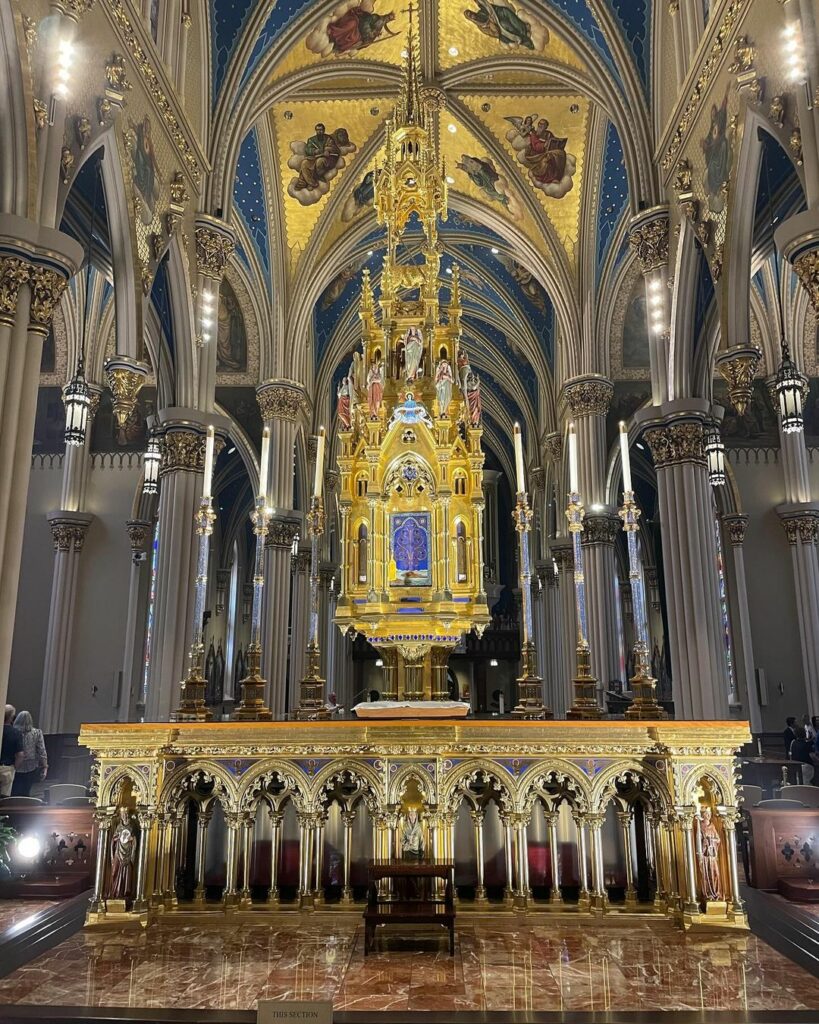
Basilica of the Sacred Heart
101 Basilica Dr, Notre Dame, Indiana
Nestled on the University of Notre Dame campus, this neo-gothic church is a major tourist attraction and is visited by more than 100,000 people each year. The church’s notable features include a 218-foot-tall bell tower, topped by a golden cross, a World War I Memorial Door, three altars, and features dozens of murals and stained glass windows.
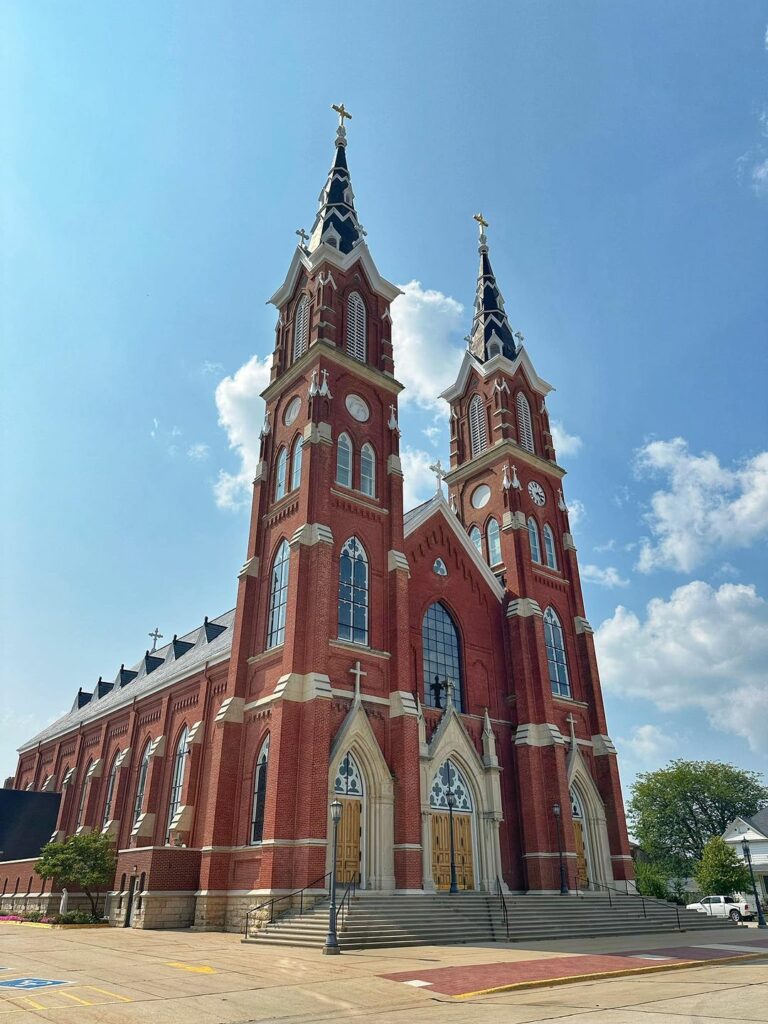
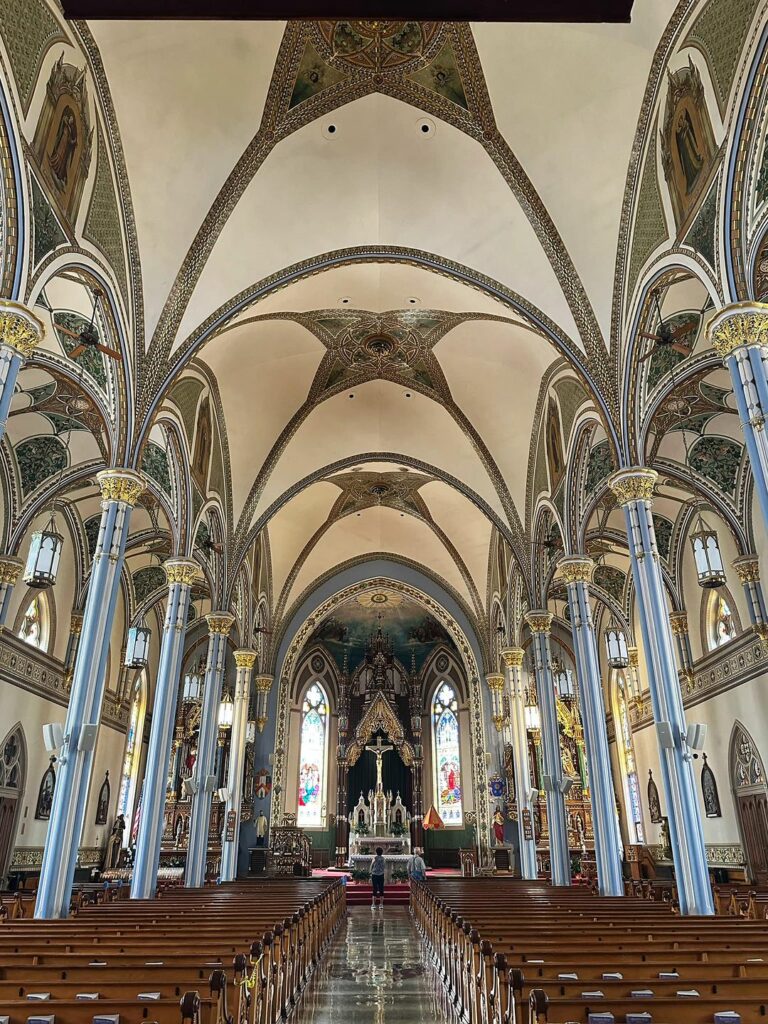
Basilica of St. Francis Xavier
104 3rd St SW, Dyersville, Iowa
Standing out among Iowa’s many cornfields, the church is built in the Rusknian Gothic Revival style with towering twin 212-foot steeples capped by 14-foot crosses — this makes the church an easily visible landmark, even from miles away. The rectangular-shaped church has dozens of cathedral glass windows, two side altars, a high altar, and the Stations of the Cross on the church’s side windows.
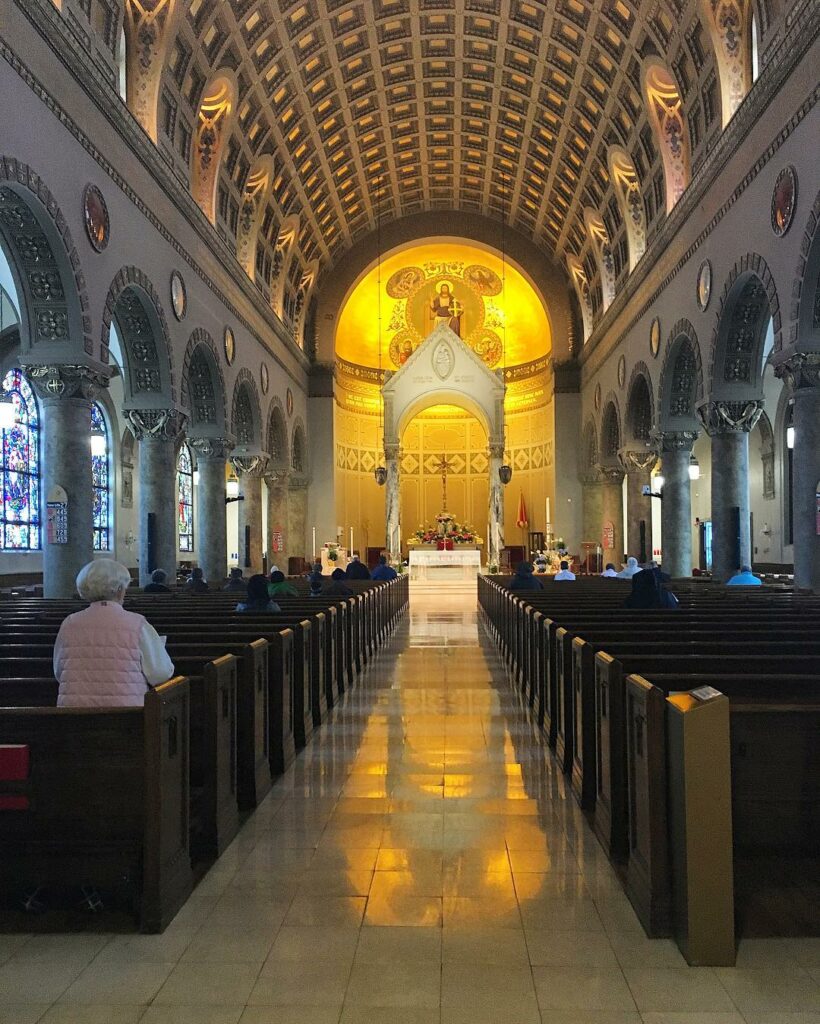
Basilica of St. John
1915 University Ave, Des Moines, Iowa
St. John’s was designed in the Romanesque Revival style typical of Northern Italy and features a 115-foot campanile with a 600-pound bell, cast in 1961. Over the main entrance, visitors will see a sculptural frame that includes a figure of Jesus Christ and angels. The church’s interior features a barrel-vaulted ceiling covered in gold leaf, stained glass windows, and different murals.
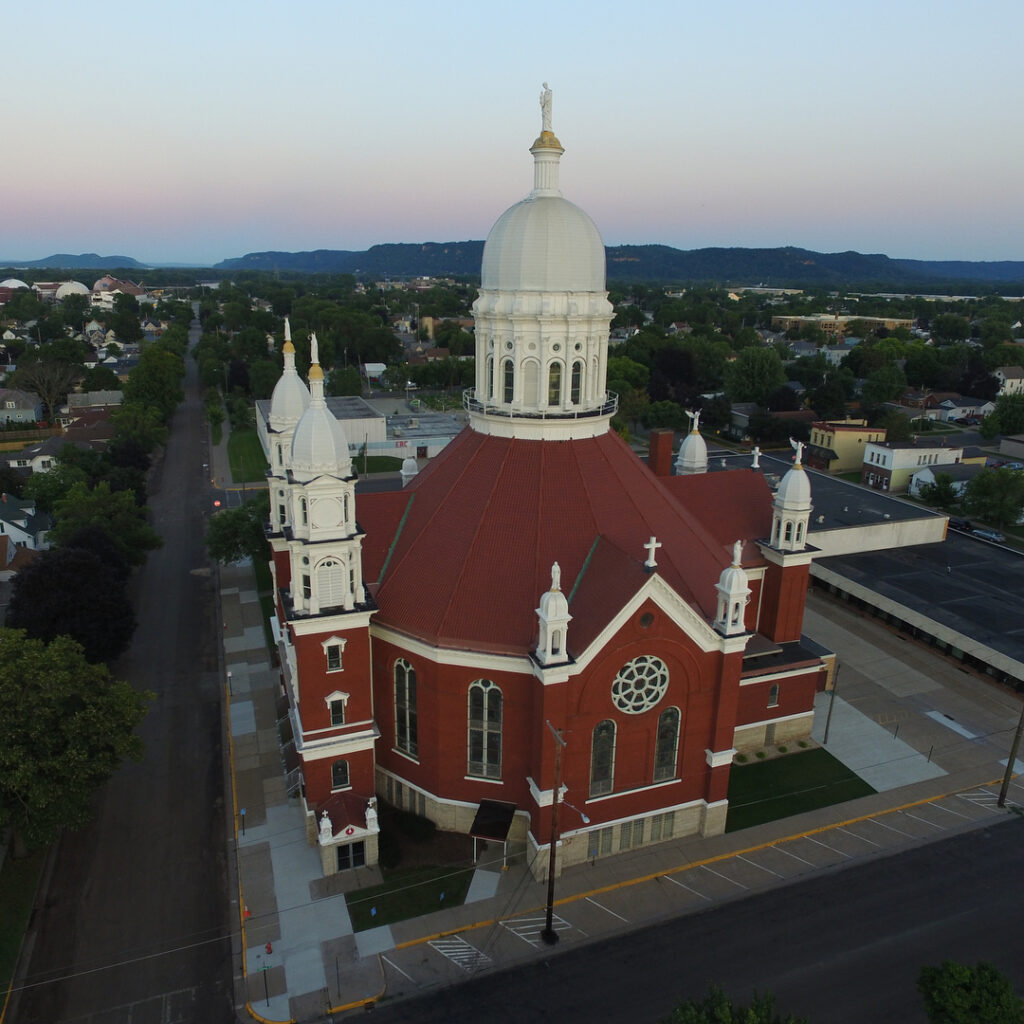
Basilica of Saint Stanislaus Kostka
625 E. 4th St., Winona, Minnesota
A prominent fixture in the city skyline, Saint Stan’s has stood tall and proud since 1895. Designed in the Polish Cathedral Style, its interior has undergone changes over the years but is still well-known for its detailed stonework, 210-foot tower, marble pillars, large stained glass windows, and dome.
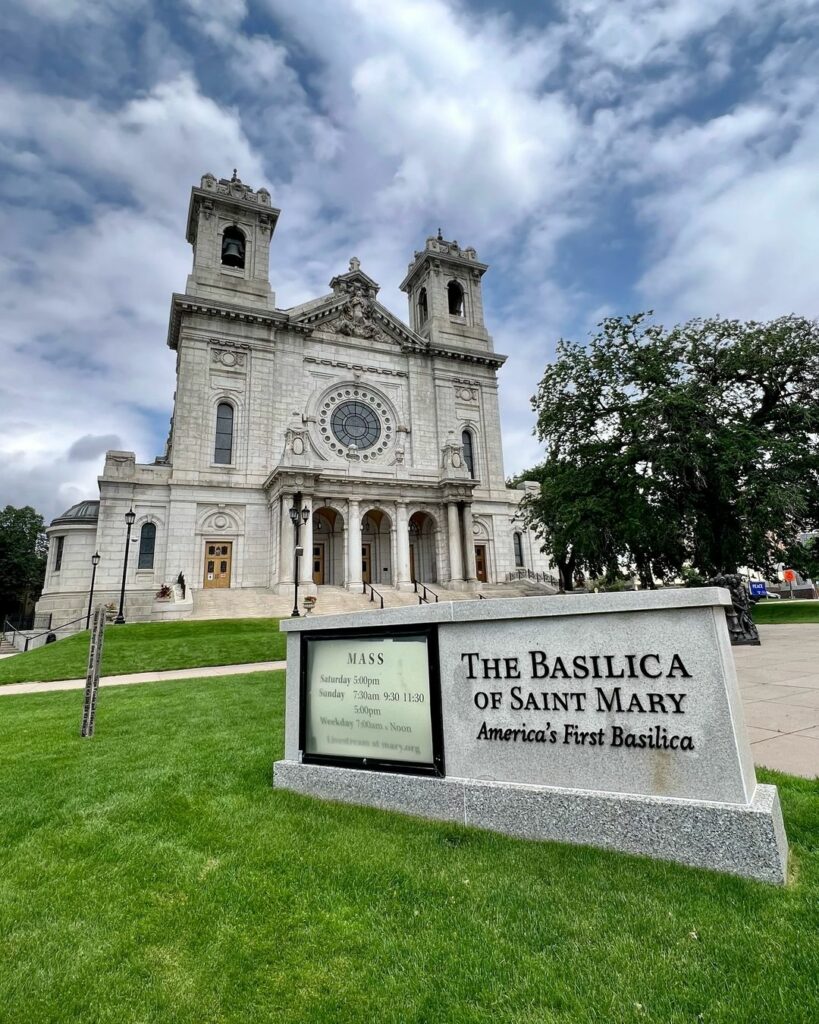
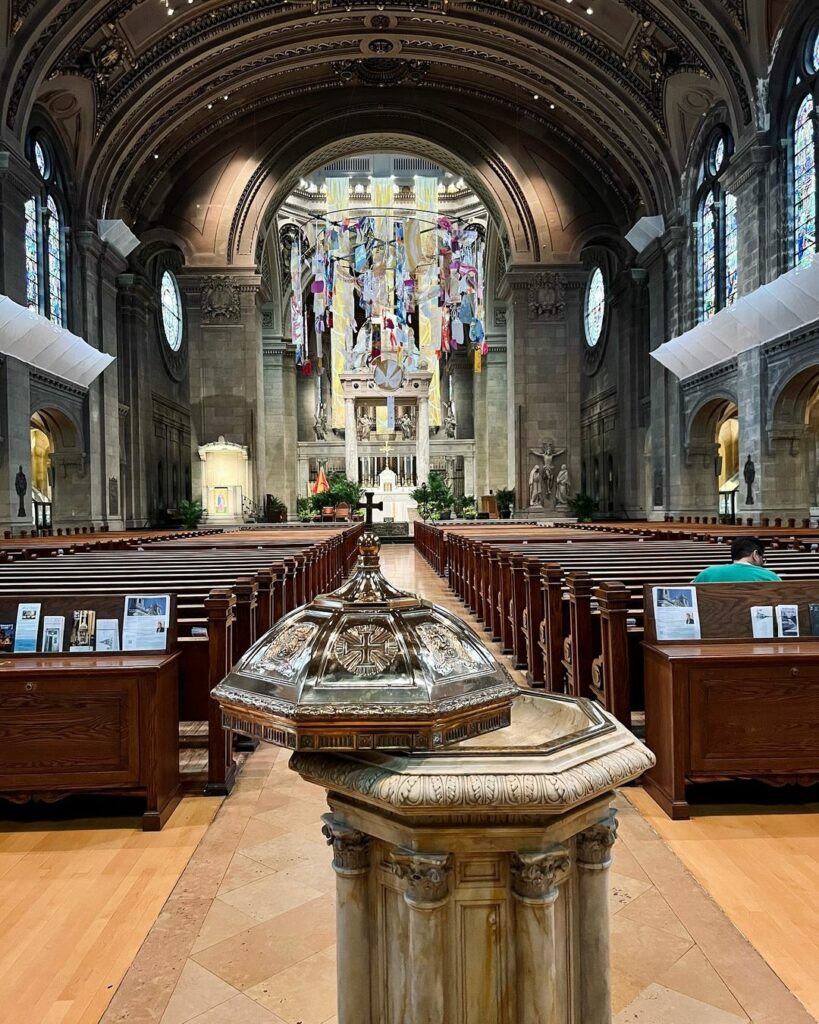
Basilica of Saint Mary
88 N 17th St, Minneapolis, Minnesota
Nestled on its own city block in downtown Minneapolis, Saint Mary’s has been a prominent city landmark since 1914 and is the nation’s first basilica.
It’s construction still stands as an example of excellent cathedral architecture — from its white granite walls to its twin 116-foot towers, to its large stained glass windows to its 82-foot barrel vault nave. The church is also known for its cathedral choir and organ, which was installed in 1949.

Basilica of St. Mary of the Assumption
132 S High St, Lancaster, Ohio
St. Mary’s is one of Ohio’s oldest parishes and the current Gothic Revival church dates back to 1864. Parishioners and visitors alike can marvel at the church’s intricate woodwork, elaborately designed statues and altars, central bell tower, and colorful stained glass windows, which are dedicated to different saints and have Polish inscriptions.
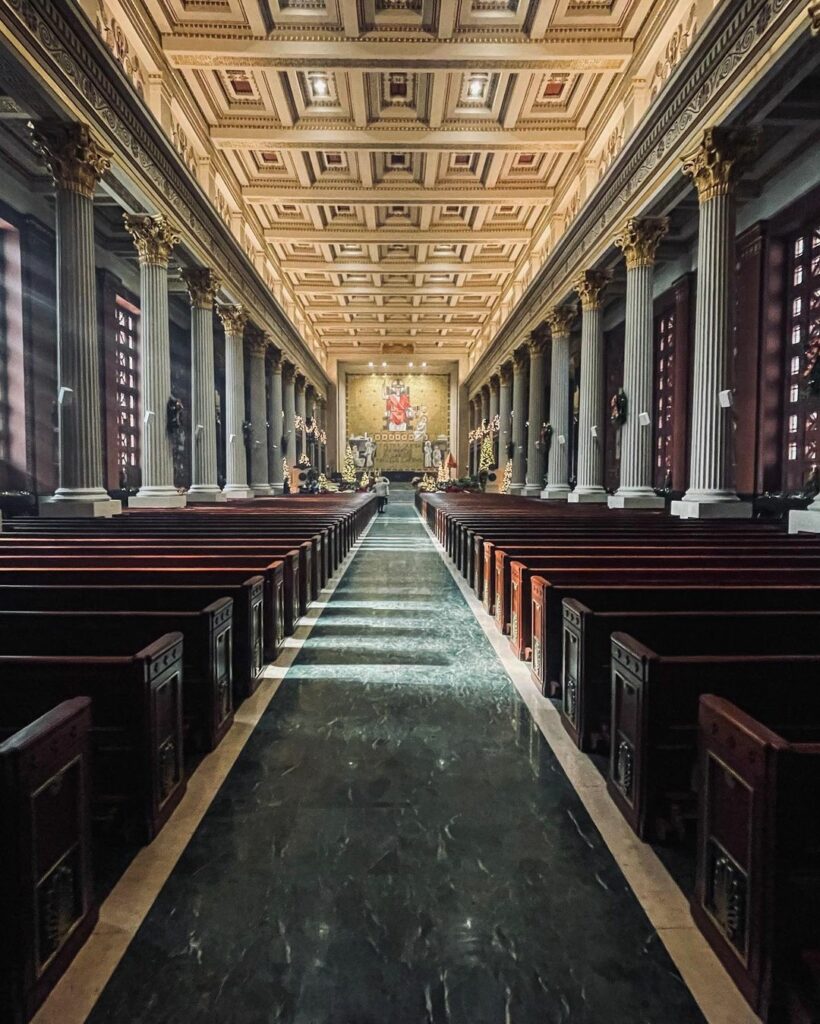
Cathedral Basilica of St. Peter in Chains
325 W 8th St, Cincinnati, Ohio
St. Peter’s massive 220-foot single spire makes the church an easily identifiable Cincinnati landmark. This Greek Revival structure was formally dedicated in 1845 and is unique among US cathedrals in that it has Greek-themed mosaics, massive bronze doors, and ornate Corinthian columns.
Basilica of Saint John the Baptist
627 McKinley Ave NW, Canton, Ohio
Completed in 1871, the basilica is designed in the Gothic Revival style and retains many elements of that style including a central spire, large stained glass windows, detailed stonework, and high vaulted ceilings. The church is also noted for its pipe organ, built by a company in Ohio, and its bell tower. The tower contains a giant clock with multiple bells and is topped by a spire that soars 180 feet into the air.
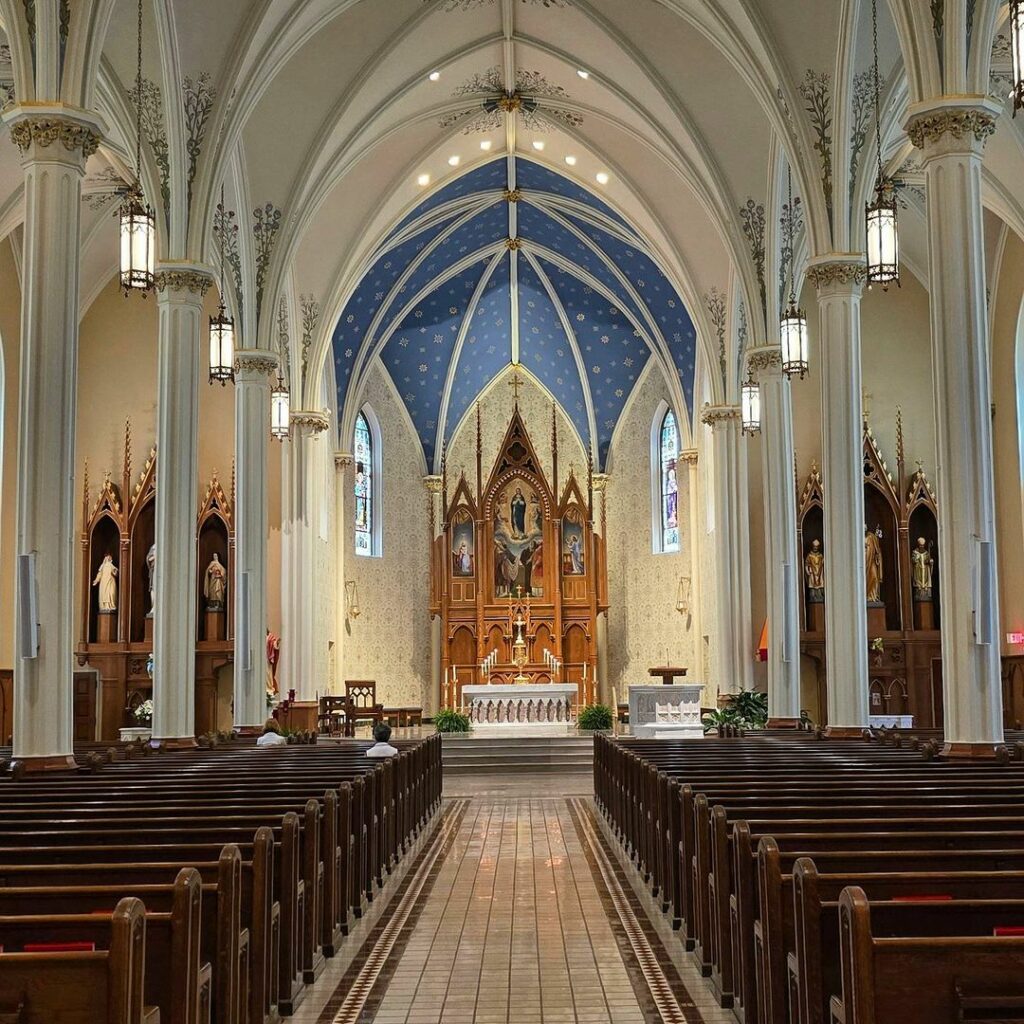
Basilica of St. Mary of the Assumption
506 4th St, Marietta, Ohio
Designed in the Spanish Colonial Revival style, the church was completed in 1909. It features twin spires adorned with pinnacles, which can be seen from a considerable distance. Visitors will immediately notice the church’s large arch entrance and the rose window above it. The interior is elegantly decorated with statues of saints, scenes from the life of Jesus Christ, high ceilings, and detailed religious artwork.
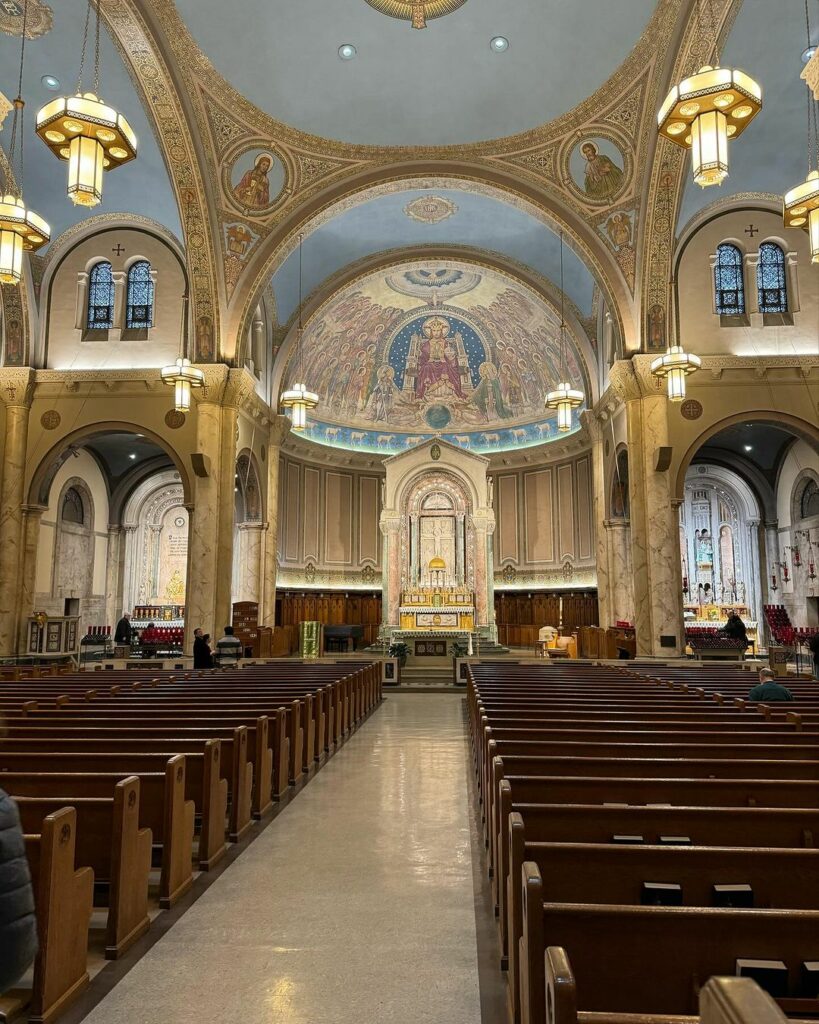
Basilica and National Shrine of Our Lady of Consolation
315 Clay St, Carey, Ohio
Though it is one of several Roman Catholic churches in Ohio, this basilica is the site of an annual pilgrimage to celebrate the Feast of the Assumption of Mary each August. It is the first US shrine to Our Lady of Consolation and the complex here includes the basilica, a parish school, and the original church from 1875.
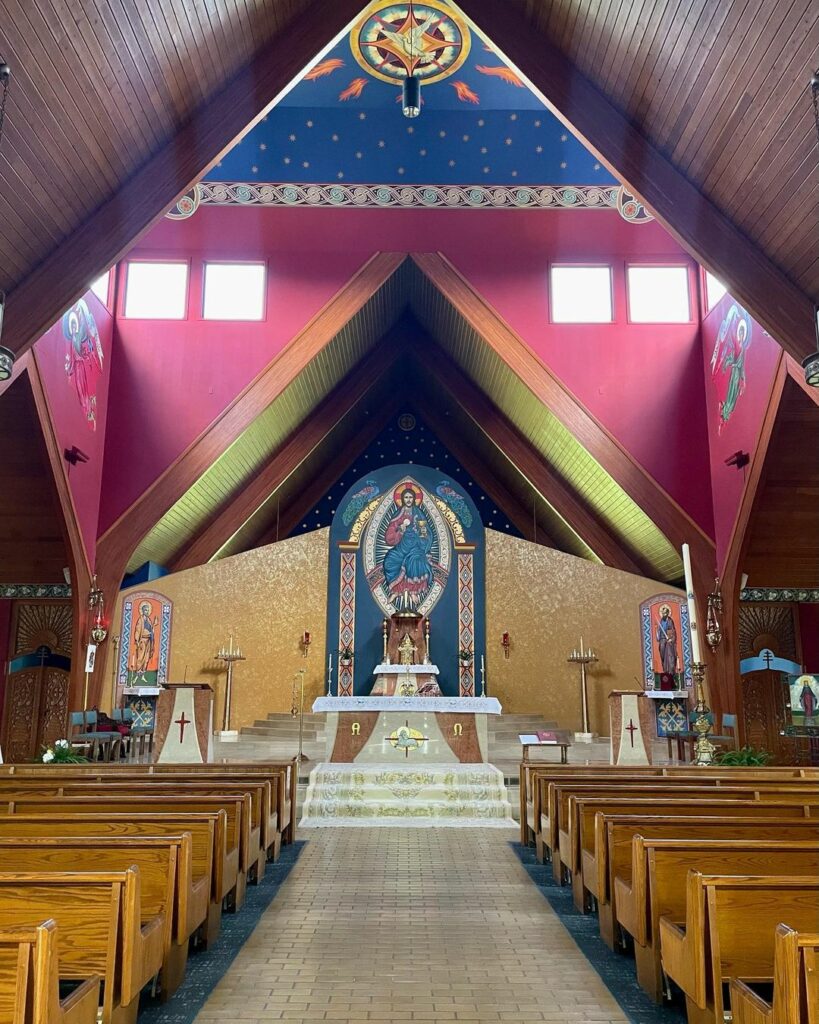
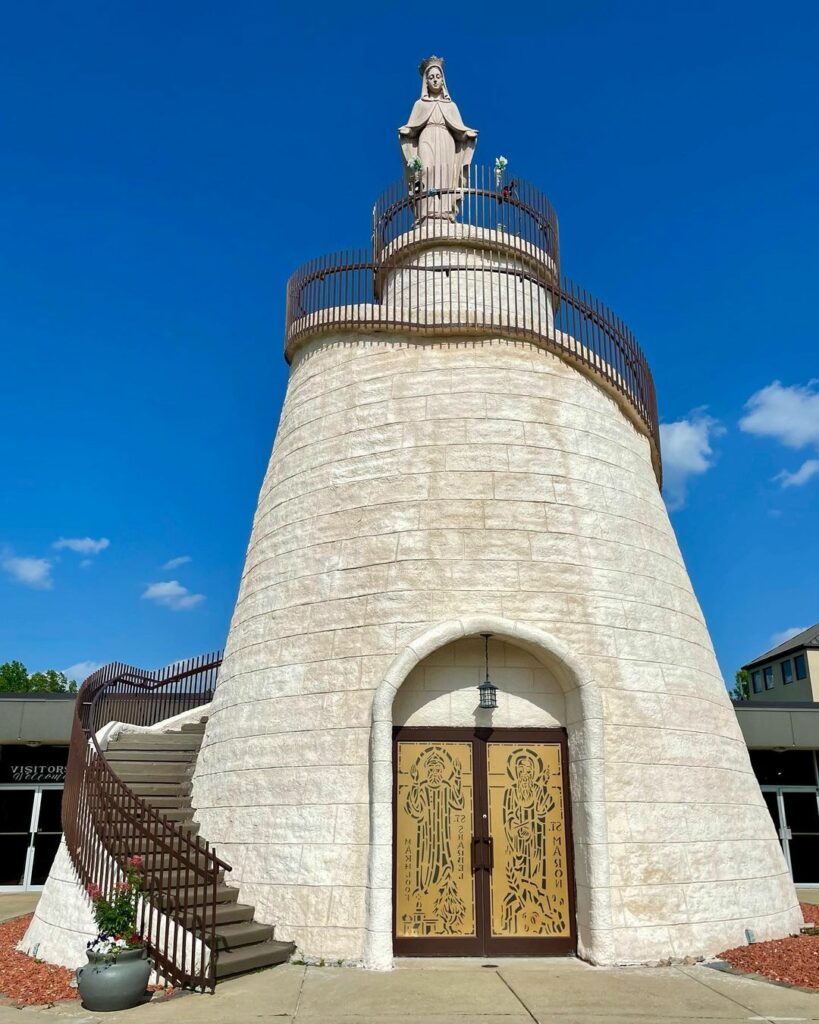
Basilica and National Shrine of Our Lady of Lebanon
2759 N Lipkey Rd, North Jackson, Ohio
The shrine was established in 1965 by members of the Maronite Catholic community and serves as a place of devotion and pilgrimage for Maronite Catholics. The basilica blends modern and traditional architecture and features a distinctive bell tower. In addition to religious artwork and furnishings, the church also has the Chapel of Our Lady of Lebanon — a special chapel used for private devotion and prayer.
Basilica of Our Lady of Mount Carmel
343 Via Mt Carmel Ave, Youngstown, Ohio
Built in 1913, this historic church was constructed in the Italian Baroque style and has been involved with the city’s long-running summer Italian festival.
It is one of the few remaining Italian parishes in the country and has undergone significant renovations over the years to restore its altars and frescos and to allow for the addition of a pipe organ, a tower, and a duplex house for religious education classes.
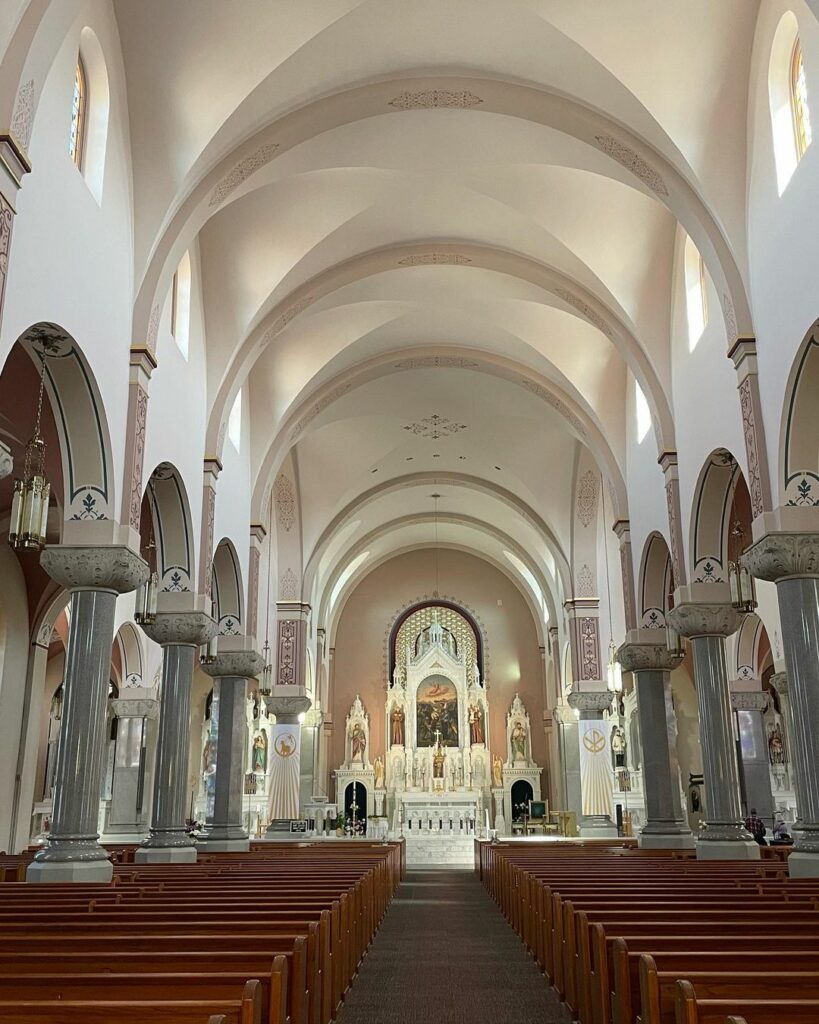
Basilica of St. Fidelis
900 Cathedral Ave, Victoria, Kansas
Also known as the “Cathedral of the Plains,” St. Fidelis grew from humble origins when it was a wooden structure attached to a settler’s house in the late 1800s.
After several incarnations, the current church was completed in 1911 and designed in the Romanesque Revival style with rounded arches and detailed stonework with native limestone. It also features a pair of 141-foot-tall towers, dozens of stained glass windows imported from Germany, and stations of the cross imported from Austria.
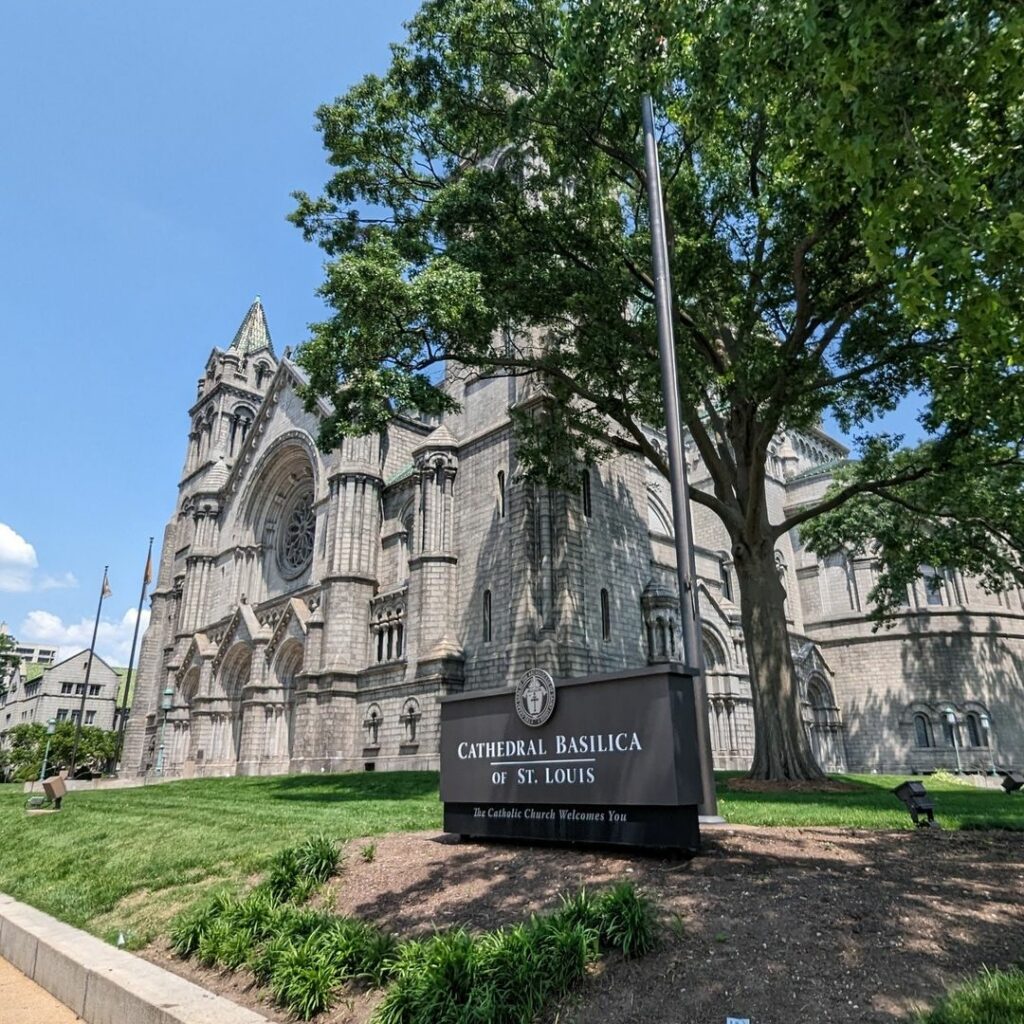
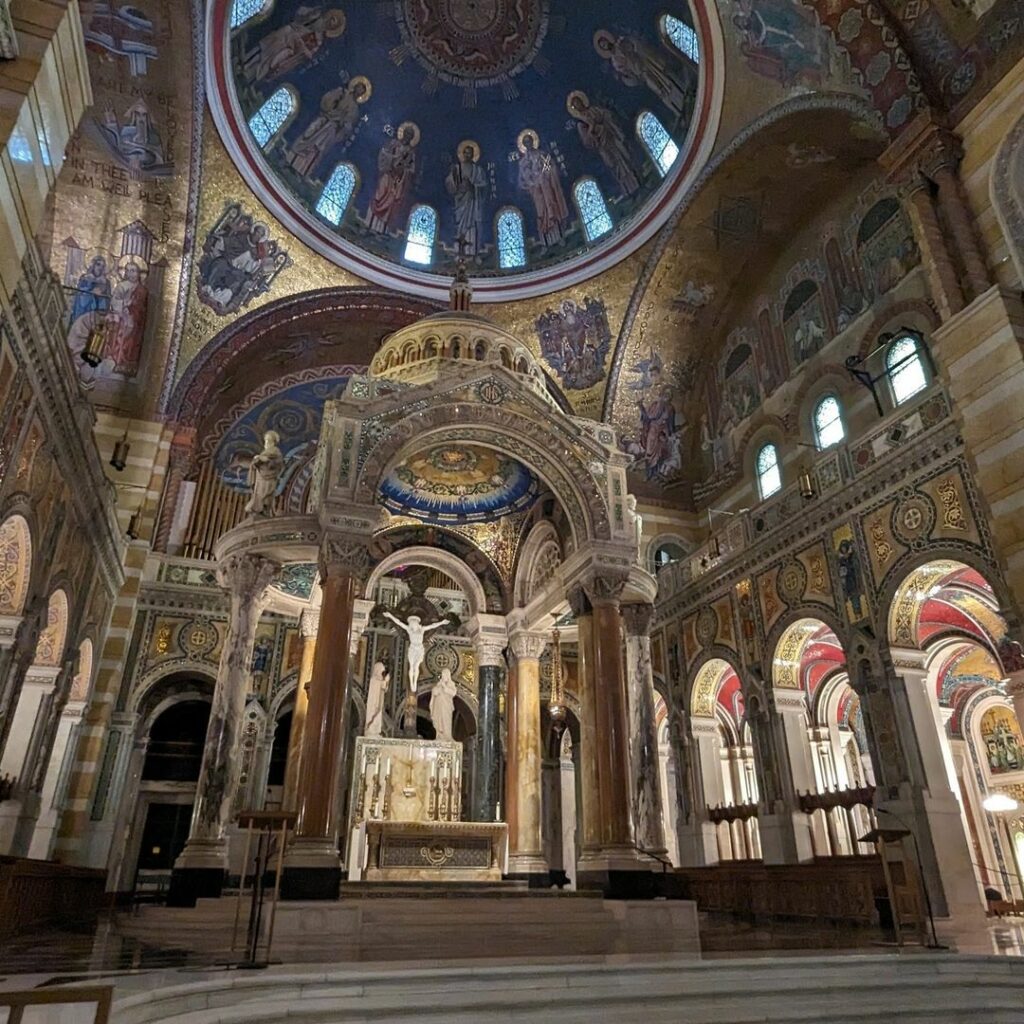
Cathedral Basilica of Saint Louis
4431 Lindell Blvd, St. Louis, Missouri
The mother church of the Archdiocese of St. Louis is well known for its sizeable mosaic installation and burial crypts. On the church’s side lawn, visitors can see The Angel of Harmony, which emphasizes peace, racial justice, and harmony.
The mosaics — first installed in 1912 and completed in 1988 — cover 83,000 square feet and contain over 40 million glass tesserae pieces in thousands of different colors. The church basement contains a museum dedicated to the mosaics and several cardinals are buried in the church crypt.
Saint Cecilia Cathedral
701 N 40th St, Omaha, Nebraska
One of the nation’s largest cathedrals, Saint Cecilia stands 255 feet long, 158 feet wide, and 222 feet tall. Designed in the Spanish Renaissance Revival style, the church features a pair of prominent 187-foot-tall towers capped by domed cupolas, and a red Spanish tile roof. Inside, visitors can admire the basilica’s high ceilings and arches as well as detailed ornamentation and artwork that adds a sense of reverence to the church.
Basilica of St. James
622 1st Ave S, Jamestown, North Dakota
Built between 1910-1914, St. James is a cross-shaped church that stands 42 feet high with twin 125-foot towers flanking the main facade. The tower spires are capped with golf-leaf crosses and the interior features stained glass windows with scenes depicting the life of Jesus Christ.
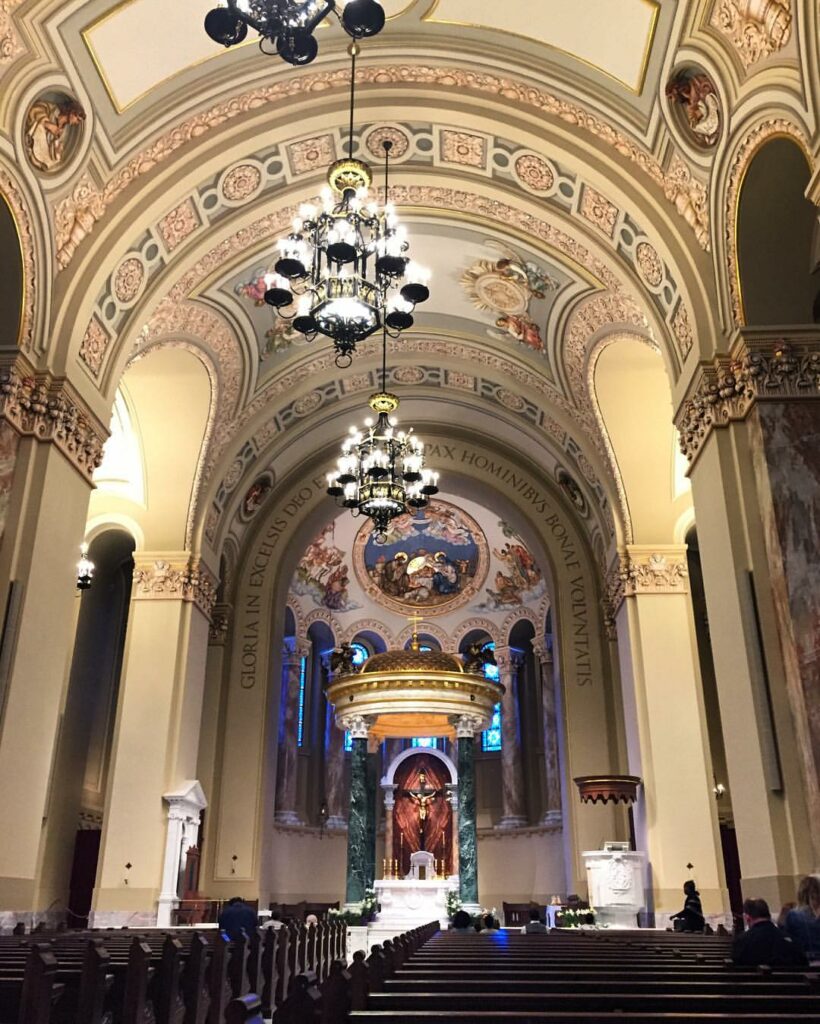
Cathedral of Saint Joseph
521 N Duluth Ave, Sioux Falls, South Dakota
Completed in 1919, St. Joseph’s was designed in the Renaissance Revival style with an exterior marked by twin bell towers, intricate stone carvings, and a large rose window. The interior features a marble high altar, French-stenciled stained glass windows, and a Kilgen pipe organ installed in 1935.
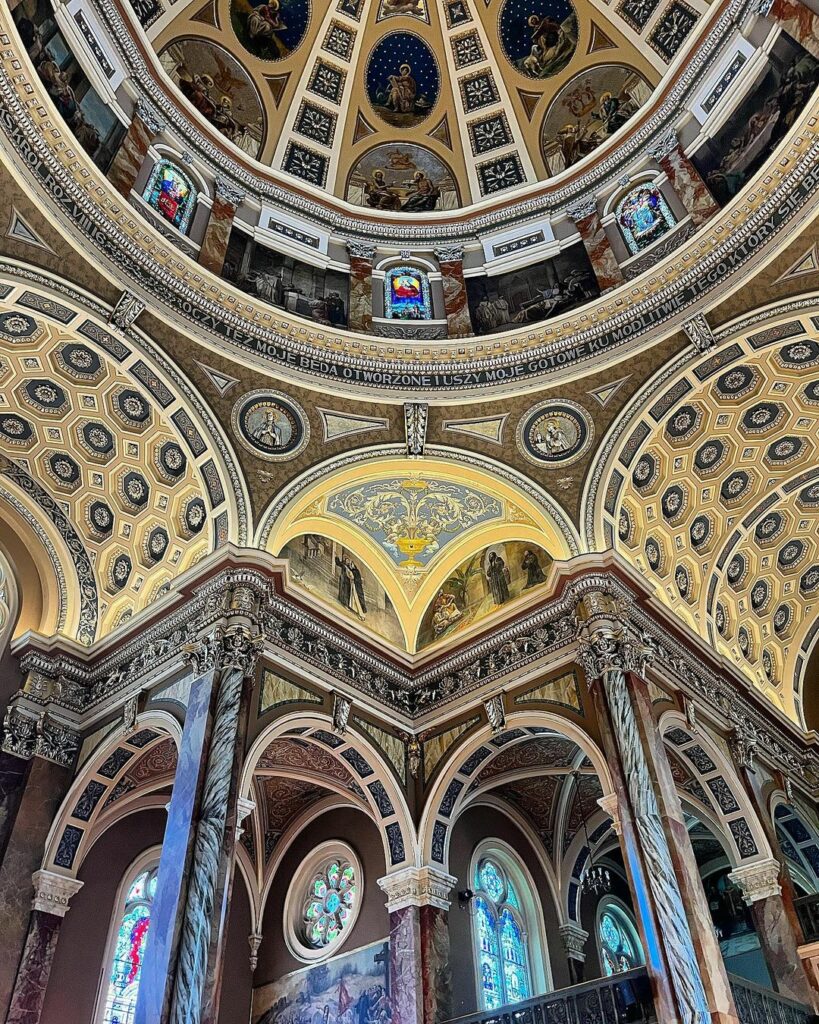
Basilica of St. Josaphat
2333 S 6th St, Milwaukee, Wisconsin
Finished in 1901, St. Josaphat is another Midwestern example of Polish Cathedral style and is well known for its grand copper dome and intricate detailing. The dome, which rises 250 feet, is the largest of its kind in the nation, and the interior features murals — including The Martyrdom of St. Josaphat — stained glass windows, and religious statues.
Plan a Trip to See a Midwest Basilica
A trip to a Midwest basilica is a special experience, whether religiously motivated or not. From their storied histories and massive size to their intricate design and decoration, there are wonders to behold around every corner. So whether you love visiting churches or historic architecture, a trip to a Midwest basilica (or two) is a fun addition to any bucket list.

